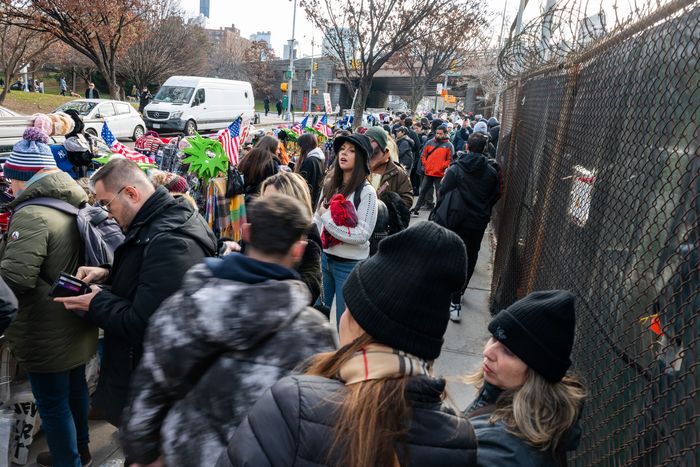
After the city banned vendors from the Brooklyn Bridge last week, Mayor Adams called the span a symbol of “what New York City is going to look like”; breezy, clean, easier to get around on. But no one had a plan for where the 50 or so vendors who had been hawking there for years would go. It now looks like many of them took the closest possible option: a block right off the Brooklyn end of the bridge, on Washington Street. On Monday afternoon, it was fully lined with 18 tables packed side to side offering Yankees beanies, toy taxis, and framed photos of the bridge they were no longer on.
“This is the spot right now,” said Michael Seri, a 65-year-old conceptual artist-slash-vendor with two tables of baseball hats and keychains. He got more business on the bridge, he said, but now catches a stream of visitors trekking to one of America’s most-Instagrammed spots: the end of Washington Street, where Dumbo warehouses frame a view of the Manhattan Bridge. Two young women who had just taken that photo passed by after picking up a magnet of the skyline ($3) and a monogrammed NYC sweatshirt ($25). One of them, Hannah Perrin, an airline worker from the U.K., said she had gotten a tip from a coworker to come here for cheap souvenirs.
For the New Yorkers who live in the area, the sudden surge of vendors from the bridge is adding to the stress of living in what one local calls Brooklyn’s “Disneyland.” Members of the Dumbo Action Committee, a neighborhood group, say the influx isn’t just annoying — it’s unsafe. They have logged vendors sleeping near their tables overnight, urinating in public, and nearly starting fires with sparky, smoking generators. But the most pressing issue is the simplest: traffic flow. Washington Street is the neighborhood’s most direct route to the 2, 3 and A, C subway stops in Brooklyn Heights. And even on a quiet Monday afternoon in January, a sale at a booth meant at least two people — a customer and a seller — were crowding a sidewalk that can, at most, fit three. Committee member Jimmy Ng says he saw the lack of space force someone to push a stroller in the road: “There has to be a balance. Right now, it’s a free-for-all.” He and other locals started calling their council member, Lincoln Restler, who stopped by last week to check it out.
Restler has been getting complaints about vendors on the street for years. So has the city; calls to 311 about merchandise vendors in that Zip Code doubled in 2017, then climbed again in 2018. But Restler now counts about ten times more vendors than there had been there before the ban, and he acknowledges that the new reality is “challenging.” “My focus is on making sure there is adequate space for people to pass,” he says. He hopes that a study of mobility and congestion in the neighborhood starting next month will clarify what the city should do.
On Friday, Restler, Ng, and other locals met to figure out their options with representatives from the Department of Sanitation, which regulates street vendors. Ng says that DSNY agreed to have a stepped-up presence to monitor the situation over the next few weeks, and the agency said it would take a “warnings-first approach whenever possible.” But the lot that vendors are stationed in front of is owned by another city agency, the Parks Department, which says it intervened this week to tell vendors without the proper permits to pack up.
The managing director of the Street Vendor Project, Mohamed Attia, says the majority of vendors who have moved to the block appear to be abiding by the law. They are licensed, allowed to keep late hours, and permitted to use generators. “Pretty much everything” the neighbors have raised could be resolved, he says. As for the public urination, he adds, “There is a public-bathroom issue across the city — not just for vendors — but for pretty much everyone.”
Restler says no one wants to drive out the vendors entirely: “We should support entrepreneurs who are trying their best to get by and meeting a demand that exists among tourists.” But he suggests the city could solve this problem by providing a designated space for sellers — maybe even a dedicated plaza. (The Parks Department lot is underused, and the city put out a request this month for developers to submit proposals for what it could become.) Without that kind of solution, Ng worries they’ll just force the vendor traffic jam into another neighborhood: “Unless you pass a law or city code to prohibit something, it’s going to be a Whac-a-Mole problem.”
“The happy medium in this city is when everyone can be like ugh,” Ng adds. “Some sort of consensus where we can be mediocrely pissed off and mediocrely content.”




